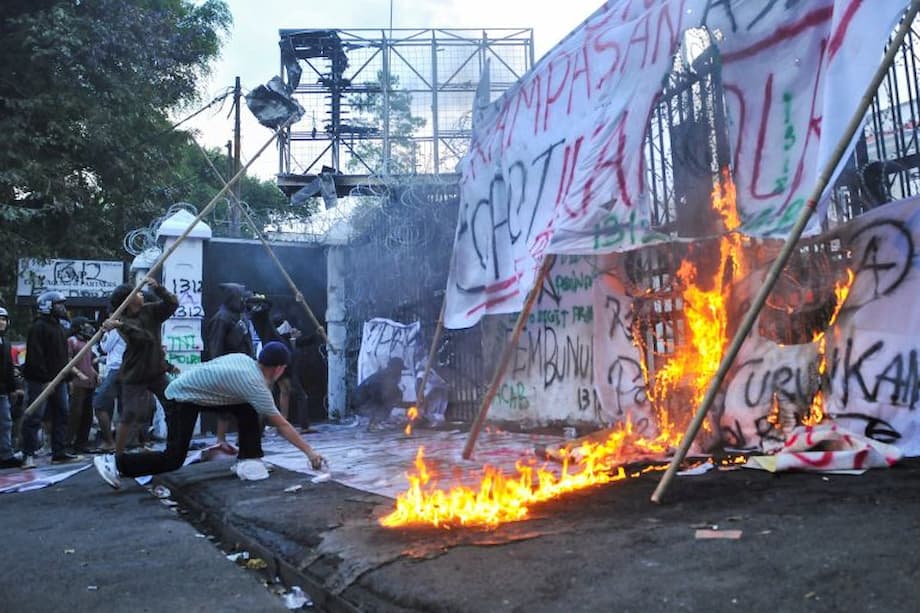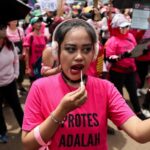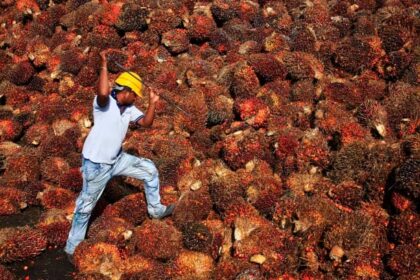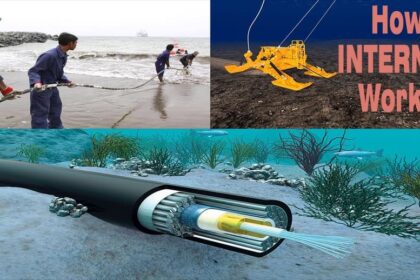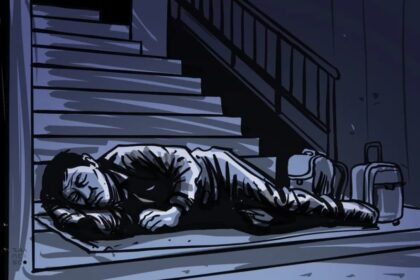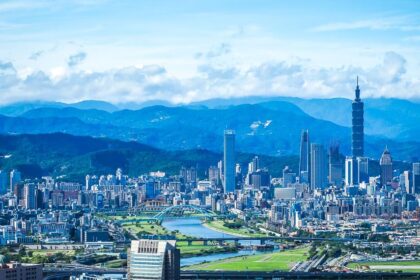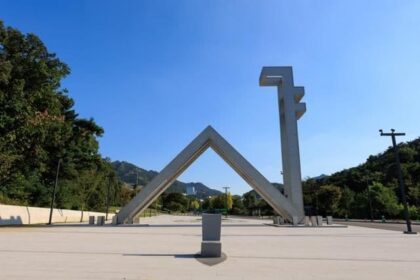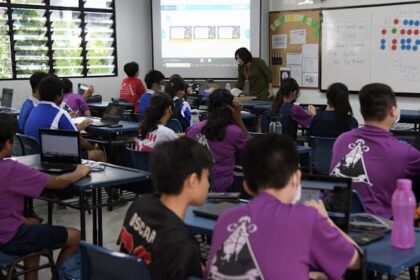Scenes from Bandung as campuses become a flashpoint
Indonesian police fired tear gas and rubber bullets near two universities in the city of Bandung, turning academic areas into the center of a fast growing protest movement that has shaken the country for more than a week. Crowds clustered around the Islamic University of Bandung (UNISBA) and nearby Pasundan University as officers attempted to disperse demonstrators after dark. Police said they did not enter university grounds and were targeting non student protesters who had moved toward campus gates to seek refuge. Student groups accused security forces of using excessive force and said at least one student was seriously hurt by rubber bullets. UNISBA officials described the campus as a medical hub for injured protesters.
- Scenes from Bandung as campuses become a flashpoint
- What sparked the unrest and how it escalated
- What happened on campus in Bandung
- Nationwide fallout, casualties, arrests and missing people
- How President Prabowo has responded
- Why campuses matter in Indonesian democracy
- Economic pressure behind the anger
- Digital mobilization and public mood
- The Bottom Line
The confrontation in Bandung is significant because it is the first time during the current unrest that police have fired at demonstrators on or near university grounds. Students and campus leaders say the setting matters. University spaces have long served as neutral ground for civic debate in Indonesia. Many students view any police action at campus gates as an attempt to silence dissent. Images of tear gas clouds outside lecture halls spread rapidly on social media, amplifying anger and drawing more attention to the grievances that sparked the protests in the first place.
The protests began over government spending and lawmakers’ benefits, then intensified after a 21 year old motorcycle taxi driver, Affan Kurniawan, died when he was struck by a police vehicle during unrest in Jakarta. Demonstrations have since spread across major cities. At least 10 people have died since last week, according to multiple reports cited by student groups and officials, and rights organizations have urged investigations into alleged abuses. The Bandung clashes underscore the stakes for Indonesia’s leadership as the country confronts economic frustration, public anger over policing, and a generation of students determined to be heard.
What sparked the unrest and how it escalated
Tension first rose outside Indonesia’s Parliament in Jakarta after reports that lawmakers were set to receive a monthly housing allowance of 50 million rupiah, a figure critics say dwarfs the monthly minimum wage for many workers. Demonstrators argued that the perk symbolized a political class out of touch with everyday hardship. Students, delivery riders, and labor union members gathered near Parliament to demand cuts to perks, a halt to new privileges, and a reordering of government priorities toward basic needs and jobs.
Rage intensified on August 28 when a police vehicle hit and killed Affan Kurniawan, a 21 year old ride share motorbike driver who had joined crowds near central Jakarta. His death became a rallying point for many Indonesians who see a pattern of heavy handed security responses. Thousands of riders attended his funeral. Motorbike taxi drivers gathered again in the capital to honor him and urged a peaceful push for change, while calling for action on wage pressures and the rising cost of living. The outpouring of grief and solidarity spilled into online spaces where Indonesians adopted protest themed profile pictures and posted demands using the hashtag #ResetIndonesia.
Protests soon spread to other islands and provincial cities, with reports of government buildings set on fire, clashes between crowds and security forces, and politicians’ homes vandalized. Civil society networks joined the mobilization, and labor unions pressed for higher minimum wages, limits on outsourcing, and stronger protections for workers. The unrest became both a protest against lawmakers’ perks and a broader expression of frustration over inequality, policing, and accountability.
What happened on campus in Bandung
According to student bodies at UNISBA and Pasundan University, officers fired tear gas from outside the campus gates after crowds gathered in nearby streets. Witnesses described volleys of canisters landing close to entrances where students had sheltered, and student leaders reported breathing problems among classmates. Police said they used tear gas to disperse non student demonstrators who had moved toward the campuses as clashes built up in surrounding areas. Authorities stressed that officers did not enter university grounds and that the priority was to clear roads and prevent further damage.
Medical volunteers and campus administrators at UNISBA said university buildings were opened to treat minor injuries and to help people suffering from tear gas exposure. One student was reported to have been critically injured by rubber bullets and required surgery, according to accounts shared by student groups. Local media and regional outlets described the Bandung incident as a turning point that raised fears about safety on campus during protests.
- Student groups say tear gas was fired from outside campus gates and that rubber bullets caused serious injuries.
- UNISBA says it operated as a medical hub to help those affected by tear gas and minor trauma.
- Police say they did not enter campuses and were dispersing crowds of non students seeking refuge near the gates.
- Student leaders argue that campus spaces should remain neutral and safe for civic activity.
Rights advocates criticized the security response in Bandung and elsewhere, calling for inquiries into the use of force and the handling of arrests. Indonesia’s human rights commission has begun reviewing the events. International organizations have echoed calls for transparent investigations and for law enforcement to avoid tactics that endanger students and bystanders.
Nationwide fallout, casualties, arrests and missing people
What began as Jakarta focused demonstrations has become a national crisis. Officials and media reports indicate at least 10 deaths since the protests escalated, with casualties recorded during clashes in several cities. In Makassar, at least three people were reported dead after a parliament building was set on fire. In Yogyakarta, activists say a student was found dead with injuries they attribute to beatings. Crowds gathered in Bali, Lombok, and cities across Java and Sumatra, with scattered arson and mob violence reported alongside peaceful rallies and vigils.
Police have detained thousands of people nationwide in connection with unrest, including more than a thousand in Jakarta alone, as authorities move to stifle rioting and looting. Civil society groups say at least 20 protesters are missing after attending rallies, with disappearances reported in multiple cities. Families and activists are pressing for information and legal assistance, while rights advocates warn that opaque detention practices fuel public distrust.
Damage in the capital has been significant, with municipal officials reporting millions of dollars in losses from burned vehicles, vandalized government property, and looted residences. Journalists have reported intimidation and rough treatment while covering the protests, and lawyers say the director of a Jakarta legal aid group was arrested during the turbulence. The scope of the response has drawn sharp criticism from human rights organizations, which argue that labeling protesters as criminals or even terrorists risks criminalizing dissent.
How President Prabowo has responded
President Prabowo Subianto is facing his first major test in office. He has urged a firm response to rioting and violence, directing security forces to maintain order while also signaling that lawmakers’ perks should be reviewed. He met with labor unions and said he asked Parliament to discuss labor laws. After nationwide backlash, officials announced cuts to some benefits and limits on overseas travel by lawmakers. The President and police leadership also apologized to the family of Affan Kurniawan, and senior officers admitted violations of professional conduct by members of a police unit.
The President initially canceled a planned trip to China to address the unrest at home, then made a brief appearance at a military parade in Beijing. The mixed signals reflect pressure to manage security while tending to foreign relations. He has characterized some violent acts during the protests as serious crimes, which prompted condemnation from rights groups that argue mass demonstrations should not be conflated with terrorism or treason. Amnesty International and others say the government needs to address the reasons people are in the streets, including police conduct and economic stress, and ensure due process for detainees.
The government has also moved to deter street clashes by setting up checkpoints around sensitive sites and by increasing the presence of security forces at key government buildings, including the presidential palace. Online platforms took steps as well. TikTok temporarily suspended its live feature in Indonesia during peak tensions, citing safety concerns. Supporters of the protests say social media remains vital for coordinating aid, documenting events, and pressing for policy reforms.
Why campuses matter in Indonesian democracy
Indonesia’s universities are not just places of study. They are also incubators of political debate and organizers of peaceful civic action. Students were instrumental in the Reformasi movement that led to the fall of President Suharto in 1998. That history helps explain why scenes of tear gas near campus gates in Bandung have resonated so deeply. A sense of campus sanctuary persists, both culturally and among student leaders who view university grounds as a refuge where people can regroup, seek medical care, and discuss strategy without fear of aggressive policing.
When police operations move close to or into these spaces, many Indonesians perceive the line between maintaining order and repressing dissent as blurred. Scholars note that student activism has often grown when authorities treat campus activity as a threat rather than as a channel for peaceful participation. In the Bandung incident, security officials say they aimed to prevent non student crowds from using campuses as cover during clashes. Student leaders argue the response jeopardized safety and discouraged legitimate civic engagement.
Economic pressure behind the anger
Although the protests were triggered by reports of lawmakers’ perks, they gained traction because they tapped into broader frustrations. Living costs have climbed, wages for many workers have not kept pace, and young Indonesians say good jobs are hard to find. Youth unemployment is high, more than 16 percent by some estimates for the Jakarta area. Many middle income households feel squeezed by housing, transport, and education costs. Controversial tax proposals and a troubled free school lunch program added to a mood of distrust toward central policies.
Labor unions that joined the protests have pressed a clear agenda. They want higher minimum wages, limits on outsourcing, and stronger enforcement of workplace protections. Workers argue that headline economic growth means little if paychecks cannot cover basic needs. Protest banners in Jakarta and Bandung linked wage demands to calls for clean government, arguing that funds earmarked for legislative privileges should be redirected to services and jobs. That message has resonated beyond union ranks, connecting students, delivery riders, and informal workers into a loose coalition.
Public anger over the death of Affan Kurniawan brought policing into the conversation about the economy. Many recount earlier cases where officers faced few consequences for heavy handed tactics. The apology from top officials and disciplinary moves against police personnel did little to calm tensions, in part because protesters see a pattern of force first responses during demonstrations. Demands now extend to police reform, better crowd control training, and clear limits on the use of rubber bullets and tear gas near civilian areas like campuses and hospitals.
Digital mobilization and public mood
Indonesia’s protest culture is both street based and digital. Organizers have used social media to share protest routes, legal advice, first aid tips, and video evidence of clashes. Hashtags such as #ResetIndonesia and the student driven “Gelap Indonesia” movement keep discussions alive even when groups retreat from the streets. Many supporters changed profile pictures to signal solidarity and posted concise lists of demands so that new participants could quickly grasp the core issues.
Internet platforms have faced pressure to moderate content during unrest. TikTok suspended live streaming during the most volatile days, saying it wanted to keep users safe. Protesters argued that live feeds protect demonstrators by creating a public record of police actions. Officials countered that false information and calls for violence also spread online. The tension reflects a wider debate about speech, accountability, and safety in a country where millions rely on social media for news and where footage from a single intersection can redefine public debate within minutes.
In neighborhoods near protest sites, residents often step in to help. Accounts from Jakarta describe people rinsing the eyes of strangers hit by tear gas and offering shelter in side streets. Small businesses have struggled when demonstrations turn violent or when authorities block access to major roads. Many shop owners say they share concerns about inequality and governance, yet fear the damage and disruption that follow when protests and police responses spiral.
The Bottom Line
- Police fired tear gas and rubber bullets near UNISBA and Pasundan University in Bandung, marking the first campus area clashes of the current unrest.
- At least 10 people have died since last week, with thousands detained nationwide and at least 20 reported missing after protests.
- The movement began over lawmakers’ benefits and intensified after the death of motorcycle taxi driver Affan Kurniawan in Jakarta.
- Rights groups and the United Nations have urged investigations into police conduct and alleged abuses during the response.
- President Prabowo signaled cuts to perks and urged debate on labor laws, while calling for firm action against rioting and looting.
- Students and labor unions have linked demands for fair wages and economic relief to calls for police reform and accountability.
- Social media has fueled organizing and documentation, even as platforms limited some features during the most volatile days.
- The Bandung campus clashes carry special weight in a country where student activism helped drive democratic change in 1998.


